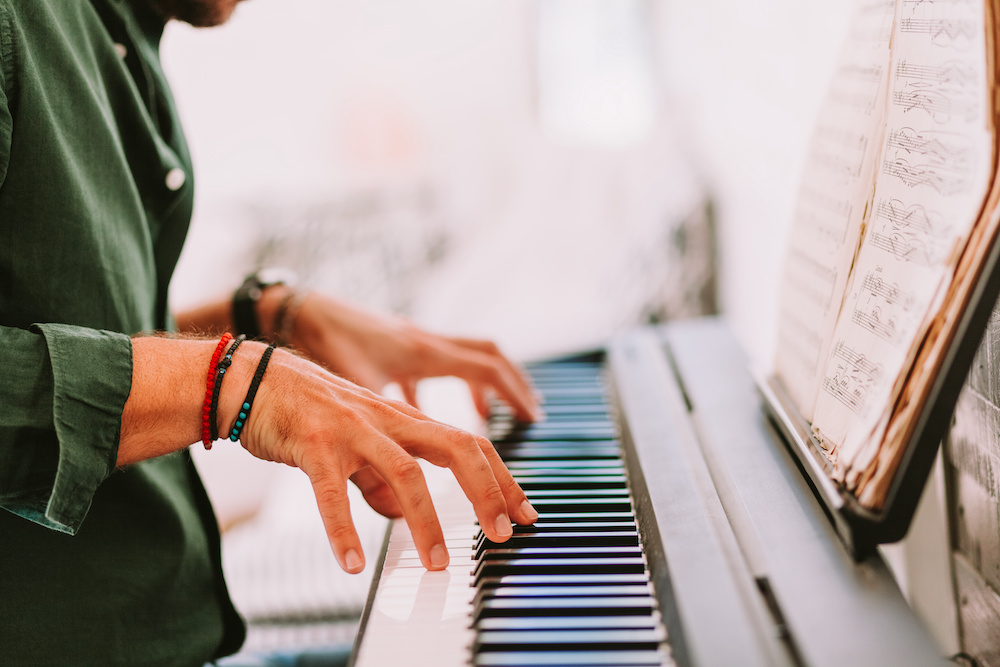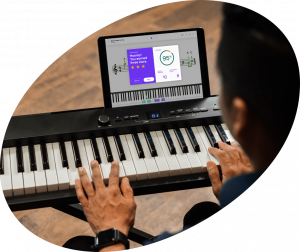The piano is a beautiful instrument that can evoke a range of emotions and feelings. Playing your favorite songs for yourself, or for a loved one, can be a deeply rewarding experience, allowing you to express yourself and connect with your audience in a really meaningful way.
In this post, we will be discussing effective strategies for learning any song on the piano. Regardless of your skill level, we believe that learning to play a new song on the piano is a great accomplishment and one of the main motivations for playing the instrument. It does require time and practice, especially for beginners, but by implementing the tips we share here, you can speed up the learning process and improve your piano playing skills.
All of the following tips and strategies follow the Playground Sessions piano learning app approach to learning songs on the piano. Our expert instructors have combined traditional methods with technology to create the ultimate learning experience. Here are some tips and strategies to help you learn any song on piano.
Start with the basics
If you’re just starting out, first day at the piano, before jumping right into the song, it would be useful to have a basic understanding of the fundamentals of piano playing. This includes knowing the names of the keys (the musical alphabet), understanding the basic rhythms, as well as understanding the different roles your right hand (melody) and left hand (harmony) each plays.
As someone brand new to learning the piano, once you have a foundation, learning new songs will be much easier. If you’ve played before, or maybe you’re an intermediate or even advanced player, there are still plenty of tips and tricks to follow here to help you along.
Listen to the song
Before you begin playing a new song, it helps a lot to listen to the song over and over again, until you have really internalized the music. By internalizing the music, this will give you a really good idea of the melody, rhythm, and overall structure of the song. Try to identify the different parts of the song, such as the verse, chorus, and bridge. Listening is really helpful, and a great first step in learning to play any song on the piano.
Break it down
Once you’ve internalized the song, it’s time to sit at the piano and begin to learn to play it. Although we all want to just play the entire song from the beginning to the end, without any mistakes, right away, no matter how advanced you are, most of the time it’s not that easy!
One of the best things you can do at first, is to break the music down into smaller sections. You can start by learning the intro of the song, or you can start with the verse or chorus. What matters is you break the song down into smaller parts and learn them one at a time.
Practice each section individually
Once you have broken the song down into smaller sections, it’s time to start practicing each section individually, one a time. This will help you to focus on the specific rhythms and notes of each section, making it easier to learn the song as a whole. It’s a really good idea to learn the right hand on its own, and then learn the left hand on its own, before bringing both hands together.
It’s harder to play piano with both hands together than it is playing one hand at a time. If you’ve practiced the right hand and left hand on their own, when you bring both hands together, everything will be easier and go much faster.
Practice slowly
When you’re first learning a section, begin by practicing slowly until you become more comfortable with the notes and rhythms. Learning a piece of music slowly is always the best way to learn. Starting slowly until you can play all of the notes correctly, and at the right time, is the best piece of advice we can give you when learning a new song.
Once you can play it slowly, speed it up in small increments until you’re able to play it at the tempo of the song, or the tempo you’ve chosen for the song. But please, start slow, it makes everything much easier for you!
Work on transitions
Once you’ve learned the different sections of the song (verse, chorus, bridge, etc.), the next step is to put all the sections together. Musicians think of this as transitioning from one section of a song to another. Transitioning between sections can often be a bit tricky as the music between the two sections can change pretty significantly.
When learning a new song, it’s important to pay attention and practice the transitions between sections. Remember to practice transitioning between sections slowly at first, and then gradually increase the speed as you become more comfortable with the music. With a bit of practice, you’ll be able to transition between sections smoothly.
Play along with recordings
Playing along with recordings of the song you’re learning is a great way to improve your playing and learn the song more quickly. Listening will help you to develop a better sense of timing and rhythm, and it will also give you a better understanding of how the song is supposed to sound. If you’re learning to play a song by ear, instead of with sheet music, playing along with the recording is one of the best and most effective ways of learning the song.

Use sheet music
If you already know how to read music, you’re in a great position to learn any new song on the piano. Sheet music can be an incredibly valuable tool when learning a new song on the piano. Sheet music, also referred to as music notation, provides a visual representation of the notes and rhythms of the song, essentially telling you which notes to play, in which hand, and when to play them.
If you can read music, you can learn your song of choice. It still may take a bit of practice to play all the notes correctly, but having sheet music as your starting point goes a long way! If you’re a beginner, it’s recommended that you find sheet music that is arranged for beginner players. As you become more advanced, you can move on to more complex sheet music that includes more advanced arrangements.
Practice regularly
Practice is the key to learning any new song on the piano, especially if your goal is to really master the song. The more you practice, the more quickly you’ll learn the song. A lot of teachers will recommend that you try to practice at least 30 minutes every day, but that’s not 100% necessary. If you are able to practice that often, you’ll definitely learn the song more quickly. What is important however is that you practice frequently enough, at least a few days a week, that you don’t forget what you worked on last.
It’s important to keep the momentum and to be able to rely on the muscle memory that comes from frequent practice. For the sections that give you the most trouble, it’s best to practice those more often, instead of practicing the sections that you’re able to get through more easily. Remember to take breaks if you become frustrated or tired, it’s always ok to walk away from the piano – it will be there when you decide to return. And be sure to practice at a slow tempo before speeding up to the tempo of the song.
Experiment with interpretation
Once you have learned the notes and rhythms of the song, it’s time to start experimenting with interpretation. This is where you can add your own personal touch to the song, such as changing the dynamics or adding your own embellishments. This will help to make the song your own and will also make it more enjoyable to play.
Have fun!
Learning a new song on the piano should be a fun and enjoyable experience. Be careful not to let the practice time or natural frustration that comes along with learning something new take away from your joy of sitting at the piano. Take time to appreciate the beauty of the music and the feeling of accomplishment that comes with learning a new song. Learning a new song on the piano is a process, and there will be ups and downs, but try your best to enjoy every part of the journey.
Now you’re ready to learn any song on piano!
In conclusion, learning to play any song on the piano requires practice, patience, and some dedication. But there are some tricks and strategies to help you learn more easily and quickly. By starting with listening to the song until you have it internalized, breaking the song down and practicing one section at a time, putting in regular practice time so you can build up muscle memory, with time you can master even the most challenging pieces of music.
Remember, playing the piano can be a deeply rewarding experience that allows you to express yourself creatively and connect with others through your music. Whether you are a beginner or an experienced pianist, the tips in this post can help you to become a better player and ensure you enjoy the many benefits that come with playing the piano. So why not start today and begin your journey to becoming a skilled pianist?

